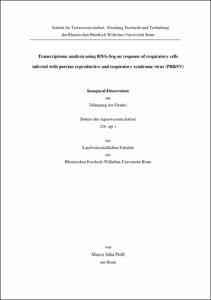Pröll, Maren Julia: Transcriptome analysis using RNA-Seq on response of respiratory cells infected with porcine reproductive and respiratory syndrome virus (PRRSV). - Bonn, 2014. - Dissertation, Rheinische Friedrich-Wilhelms-Universität Bonn.
Online-Ausgabe in bonndoc: https://nbn-resolving.org/urn:nbn:de:hbz:5n-38304
Online-Ausgabe in bonndoc: https://nbn-resolving.org/urn:nbn:de:hbz:5n-38304
@phdthesis{handle:20.500.11811/5867,
urn: https://nbn-resolving.org/urn:nbn:de:hbz:5n-38304,
author = {{Maren Julia Pröll}},
title = {Transcriptome analysis using RNA-Seq on response of respiratory cells infected with porcine reproductive and respiratory syndrome virus (PRRSV)},
school = {Rheinische Friedrich-Wilhelms-Universität Bonn},
year = 2014,
month = nov,
volume = 172,
note = {The porcine reproductive and respiratory syndrome (PRRS) is one of the most important viral diseases of the swine industry worldwide (Balasuriya 2013). Its aetiological agent is the PRRS virus (PRRSV) (Balasuriya 2013, Conzelmann et al. 1993). The understanding of the genetic elements and functions, involved in the response to PRRSV and the comprehension of the changes in the global transcriptome profile post infection, remain still unclear.
Main objectives of this thesis are to characterize the global transcriptome profile of PRRSV infected lung DCs, by using the RNA-Sequencing (RNA-Seq), to improve the understanding of genetic components in the response to PRRSV as well as to determine the changes in the expression profile in different respiratory cells post PRRSV infection.
Six female 30 days old piglets of two different porcine breeds (Pietrain and Duroc) were selected, PAMs, lung DCs and trachea epithelial cells were isolated and infected with the European prototype PRRSV strain Lelystad virus (LV). Non-infected (0 h) and infected (3, 6, 9, 12, 24 hpi) lung DCs, PAMs and trachea epithelial cells as well as cell culture supernatants were collected. Non-infected and infected lung DCs of both breeds were used for RNA-Seq. The sequence alignment was done with the reference genome build Suscrofa 10.2 and with the complete genome of LV strain.
The transcriptome analysis of PRRSV infected lung DCs of Pietrain and Duroc resulted in an amount of 20,396 porcine predicted gene transcripts. The virus sequence alignment exhibited that the LV strain was able to infect lung DCs and to replicate there. Not only breed-differences post PRRSV infection in the virus growth, also breed-differences in the cytokine concentrations as well as in the detected mRNA expression profiles and in the differently expressed genes were identified. Beside these breed-dependent differences, cell-type dependent differences in the response to PRRSV were characterized. 37 clusters for Pietrain and 35 clusters for Duroc and important pathways were identified.
This thesis is the first comprehensive study that described the transcriptome profile of two different breeds post PRRSV infection, especially of infected lung DCs. The main findings of the investigations showed that the virus-host interaction was different for the various respiratory celltypes and that the gene expression trends proceeded contrarily for both breeds during the first time points after infection. Additionally, key clusters, key pathways and specific gene transcripts were identified.},
url = {https://hdl.handle.net/20.500.11811/5867}
}
urn: https://nbn-resolving.org/urn:nbn:de:hbz:5n-38304,
author = {{Maren Julia Pröll}},
title = {Transcriptome analysis using RNA-Seq on response of respiratory cells infected with porcine reproductive and respiratory syndrome virus (PRRSV)},
school = {Rheinische Friedrich-Wilhelms-Universität Bonn},
year = 2014,
month = nov,
volume = 172,
note = {The porcine reproductive and respiratory syndrome (PRRS) is one of the most important viral diseases of the swine industry worldwide (Balasuriya 2013). Its aetiological agent is the PRRS virus (PRRSV) (Balasuriya 2013, Conzelmann et al. 1993). The understanding of the genetic elements and functions, involved in the response to PRRSV and the comprehension of the changes in the global transcriptome profile post infection, remain still unclear.
Main objectives of this thesis are to characterize the global transcriptome profile of PRRSV infected lung DCs, by using the RNA-Sequencing (RNA-Seq), to improve the understanding of genetic components in the response to PRRSV as well as to determine the changes in the expression profile in different respiratory cells post PRRSV infection.
Six female 30 days old piglets of two different porcine breeds (Pietrain and Duroc) were selected, PAMs, lung DCs and trachea epithelial cells were isolated and infected with the European prototype PRRSV strain Lelystad virus (LV). Non-infected (0 h) and infected (3, 6, 9, 12, 24 hpi) lung DCs, PAMs and trachea epithelial cells as well as cell culture supernatants were collected. Non-infected and infected lung DCs of both breeds were used for RNA-Seq. The sequence alignment was done with the reference genome build Suscrofa 10.2 and with the complete genome of LV strain.
The transcriptome analysis of PRRSV infected lung DCs of Pietrain and Duroc resulted in an amount of 20,396 porcine predicted gene transcripts. The virus sequence alignment exhibited that the LV strain was able to infect lung DCs and to replicate there. Not only breed-differences post PRRSV infection in the virus growth, also breed-differences in the cytokine concentrations as well as in the detected mRNA expression profiles and in the differently expressed genes were identified. Beside these breed-dependent differences, cell-type dependent differences in the response to PRRSV were characterized. 37 clusters for Pietrain and 35 clusters for Duroc and important pathways were identified.
This thesis is the first comprehensive study that described the transcriptome profile of two different breeds post PRRSV infection, especially of infected lung DCs. The main findings of the investigations showed that the virus-host interaction was different for the various respiratory celltypes and that the gene expression trends proceeded contrarily for both breeds during the first time points after infection. Additionally, key clusters, key pathways and specific gene transcripts were identified.},
url = {https://hdl.handle.net/20.500.11811/5867}
}






